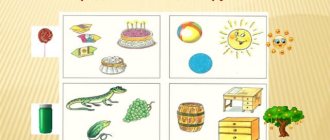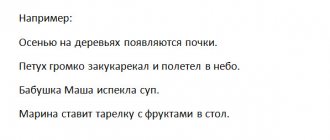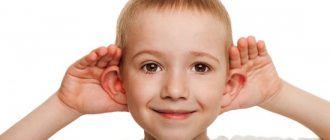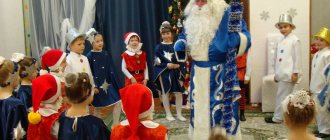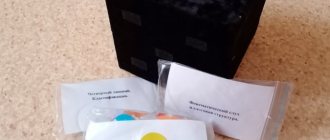Card index of didactic games for the development of phonemic processes in preschoolers
Card index of didactic games for the development of phonemic processes.
Recognition of non-speech sounds.
Goal: development of auditory perception skills based on non-speech sounds. Objectives: learn to recognize the sounds of toys, musical instruments, the voices of animals and birds, and the sounds of the surrounding reality. “What did that sound like?”
An adult behind a screen plays a musical instrument.
The child guesses it and names it. "Whose voice?"
The child listens to an audio recording of animal voices and determines who the voices belong to.
“Find a Pair”
To play, you need identical boxes with different contents: cereals, grains, pasta, small metal and plastic objects.
The child looks for identical sounding boxes without opening them; by sound. “Magic wand”
An adult knocks with a “magic wand” on various objects: wood, glass, plastic, metal.
The child remembers the sound and then guesses, without visual support, what the stick hit. “Magic chest”
Determine by ear what is hidden in the chest.
“Find out by sound”
The child turns away, the adult drops some objects. We need to find out what fell.
Distinguishing the height, strength, timbre of the voice on the material of identical sounds, combinations of words and phrases.
Goal: to learn to distinguish by ear the direction of sound, longitude, continuity, tempo, volume, pitch and rhythm on a variety of speech material. Objectives: learn to reproduce and differentiate rhythms based on visual, auditory and motor analyzers; develop auditory and visual attention, memory, sense of rhythm, ability to change the voice in pitch, strength, duration. “Song of the Rain”
An adult behind the screen plays the “song of the rain” on the metallophone.
The child determines what kind of rain sang the song - beginning or torrential and chooses the appropriate pattern. As a complication, you can invite the child to play the “rain song” according to the diagrams. “Wind”
An adult behind the screen hums in a low or high voice: “Oooh!”
The child guesses whether the wind is blowing strong or weak and shows the corresponding picture. “Repeat the rhythm”
The adult behind the screen claps some rhythm, the child repeats it.
A more complicated version - the child sings a rhythm written in symbols. For example: !! !!! !! , Where ! - clap, space - pause. “The Three Bears”
An adult behind a screen pronounces any phrase from the fairy tale “The Three Bears” in a low or high voice. The child must guess which character’s voice he heard.
“Sounding Sun”
To play you will need a piece of paper and a yellow pencil.
In the middle of the leaf you need to draw a circle - the sun. The teacher behind the screen pronounces a sound or plays a musical instrument. If the sound was long, the child draws a long ray of sunlight, if it was short, a short one. “Steamboat whistle”
An adult behind the screen hums in a low or high voice: “Oooh!”
The child guesses which steamboat is humming, big or small. “Bear”
The child - the driver stands with his back to the others. Children say the phrase: “Bear, Bear, we came to you, we brought honey.” Then they take turns saying: “Bear, I’m here!” The driver must guess the speaker without turning around.
Distinguishing between words that are similar in sound composition.
Goal: development of phonemic awareness. Objectives: to develop the ability to distinguish words that sound similar. “Race”
An adult offers to organize a race.
Children stand in a line at a distance from the speech therapist and, on command, begin to move forward. When everyone hears the word “stop,” they should freeze. The words are pronounced: elephant, moan, stop, drain, stop, stand, knock, hear, elephant, stop, chair, stop, stop. The child who was the most attentive wins. “Find yourself a pair”
The child has several pictures in front of him, he must choose a pair so that the words sound similar: bear - bowl.
To complicate the task, choose a rhyme yourself. “How are the words different?”
The child determines how the words differ.
For example, kit-cat, beetle-bitch, Masha-porridge, ball-scarf. “Extra word”
The child identifies the extra word in the series and explains his choice.
For example: ditch, ditch, cocoa, ditch. Poppy, buck, yes, banana. “Find the letter”
Children look for the “lost” letter and replace it with the correct one. The game is played based on pictures. Puddles-skis Cow-crown Folder-stick Squirrel-bun Kit-cat Crust-cat
Differentiation of syllables.
Goal: developing the ability to differentiate syllables. Objectives: learn to differentiate syllables that differ in several or one sound using the material of syllables of different structures. “Deaf telephones”
Children sit in a row, one after another.
The adult calls a syllable or series of syllables in the ear of the first child. He whispers to the next one, etc., the last child says out loud what he heard. If a mistake is made, all participants in the game repeat their options and it is determined who made the mistake. “Which one is different?”
An adult pronounces a series of syllables (for example: nu-nu-no, sva-ska-sva, sa-sha-sa, etc.) and invites the children to determine which syllable differs from the others and in what way.
“Living syllables”
Three children memorize one syllable each and go behind the screen, and when leaving there, pronounce them; the rest of the guys determine which syllable was the first, second and third. Later, syllables that make up a word are introduced into the games, for example MA-SHI-NA; after naming the syllable series, the children answer what happened, or find such a picture among others.
Phoneme differentiation.
Goal: development of phonemic hearing. Objectives: learn to isolate a sound from a number of other sounds, syllables, words. “Who listens better?”
Two children stand with their backs to each other.
An adult makes a series of sounds. The first one raises his hand if he hears a sound, for example, [f], the second - [w]. “Sound mosaic”
A grid is drawn on a piece of paper.
If the child hears the sound [a] (as in “the baby is crying”), he paints the cell red, if there is no given sound, he paints it yellow (any other). You can use chips of the specified color. “Catch the sound”
The adult names the words, the child claps his hands if he hears a word with a given sound.
“Tangles”
Help grandma collect the balls.
In a separate basket, place balls with designs that have a given sound in the name. “Speech therapy daisy”
The child must make a daisy from petals, choosing only petals with pictures whose names contain a given sound.
“Dress up the Christmas tree”
To decorate the New Year tree, the child must choose to determine whether the given sound is in the name of the picture drawn on the Christmas tree ball.
“Birthday of Sound”
Friends of sound will come to the birthday party - those words that contain this sound.
The game can be played either with or without the help of pictures. “Labyrinth”
Guide the hero through the labyrinth so that along the way he encounters only objects whose names contain a given sound.
“Seat in the carriages”
The adult says that in the carriage on the left there will be animals whose names contain the sound “Zh” (“bug song”), and in the carriage on the right there will be animals whose names have the sound “SH” ( "song of the wind")
The child determines the presence of given sounds in words and places the animals in their places. “Sound Lotto”
Equipment: playing fields according to the number of people, cards with pictures.
Four people play. Everyone must collect only words with a certain sound. For example: [P], [Pb], [L], [L]. The one who covers his entire playing field the fastest wins. “Collect the beads”
Laura and Lilya scattered the beads.
If there is a picture on the bead whose name is soft [L], the child gives the bead to Lila, if it is hard [L] - to Laura. “Assemble a letter”
To play the game you need to make cardboard letters and cut them into several parts.
Glue a picture to each particle, the name of which begins with the sound that this letter represents. The child must determine the first sound in a word and assemble a letter from parts. “Help Masha and Mishka”
Masha and Mishka want to decorate the house for the holiday with flags.
Help them select only the flags with pictures that have the given sound in their names. “Pack your suitcase”
The adult says: “We are going on a trip. We will take with us only those items whose names begin with a certain letter “. The game can be played either with or without the help of pictures.
Development of basic sound analysis skills.
Goal: to develop skills in sound analysis and synthesis. Objectives: developing the ability to determine the place of a sound in a word, select words with a given sound, compose words from individual sounds, differentiate sounds by hardness - softness, voicedness - deafness, perform phonemic analysis of words; determine the sequence and number of sounds in a word; the location of a sound in a word in relation to other sounds. "Who is bigger?"
An adult and a child take turns coming up with words with a given sound.
The one who says the word last wins. “Chain of words”
(analogue of the “city” game) An adult and a child take turns naming any words, with each subsequent word starting with the last sound of the previous word.
“Gather a word”
An adult pronounces a word by sounds, for example, K, O, T, the child must guess what word it is.
“Guess the name”
To play the game you need to select pictures or toys in such a way that the first letters of their names make up the name.
Instructions: “Here is the doll. To guess her name, you need to name the first sounds in the words and make a name from them.” For example: car (M), bus (A), Shrek (W), Watermelon (A) - MASHA. You can complicate the conditions - make up a word, for example, using the second or last sounds of words. “Words Scattered”
The game is intended for children familiar with letters.
You need to make a “scattered” word from individual letters. “The fourth odd one”
An adult names four words, three of which begin with the same sound, and the fourth with a different one.
The child identifies the first sounds in words and says which word is the odd one out. Similarly, the fourth odd one is determined by the last sound - then the names of three objects must end with the same specific sound. “Beginning, middle, end”
The adult pronounces words with a certain sound, and the child, depending on the position of the sound in the word, says: “beginning” (if the given sound is at the beginning of the word), “middle” (if the given sound is in the middle of the word), “ end" (if the given sound is at the end of the word).
“What sound (syllable) did the Letter Eater eat?”
The letter eater ate the first sound (syllable) in words.
You need to guess which sound (syllable) is missing and name the original word. “Find all the objects that begin with the sound …”
The adult asks the child to name all the surrounding objects whose names begin with a certain sound (for example, K).
“Distributed into houses”
Toys or pictures need to be distributed among three houses.
In the first house we put those toys whose names have the given sound at the beginning, in the second - those toys whose names have the given sound in the middle, in the third - at the end. “General sound”
You need to guess what sound is in all these words.
For example: vase, tooth, dragonfly, jellyfish, hare - the general sound is [z]. “Tell Parsley the sound.”
Parsley names objects (pictures), but does not finish the last sound.
The child must suggest the sound not uttered by Parsley. “Dunno’s riddles”
Dunno sent a letter: “I am sending a piece of paper with words.
Guess what words I have in mind.” The letter contains words with missing letters. You need to guess which letters Dunno missed and what words he guessed. “Battleship”
One syllable is written in each cell of the playing field.
The adult names the coordinates, the child writes down the syllables, and then reads the resulting words. “Refueling”
To play, you need a toy car and three cubes.
The cubes will act as columns at the gas station. The adult names the words. If the given sound is heard at the beginning of the word, the child places the car near the first gas station, in the middle - near the second, at the end - near the third. In the second option, the adult places the car near the middle gas station (first or last), and the child comes up with a word in which the given sound will be in the middle of the word (beginning or end). “Enchanted Word”
An evil wizard bewitched the words so that only the first and last letters remained.
Disenchant them. You can offer object pictures as a hint. “Tie the Balls”
For the game you need an image of balls with drawings.
The child determines the hardness/softness of a given sound in the names of the pictures. If the sound in the word is hard, you need to draw a blue thread to the ball, if it is soft, green. “Bug”
The beetle got sick and all the spots on its wings disappeared.
Remember words with the sound [zh], and then dots will appear on its back again. “Encryptors”
The child becomes an encryptor; he must encrypt words - replace all the sounds in them with symbols, i.e.
perform a phonemic analysis. “Collect the balls”
To play the game you need cards with balls on one side and various objects on the other.
The child needs to put the balls into boxes. If the name of the picture begins with a vowel sound, it should be placed in a red box, if with a hard consonant - in a blue box, if with a soft consonant - in a green box. In the second option, instead of balls, you can use circles of three colors. The child takes out one “ball” from the box and comes up with words. If the ball is red, you need to come up with a word for a vowel sound, blue - for a hard consonant, green - for a soft consonant. “Mosaic”
Purpose: differentiation of vowels and consonants, hard and soft sounds. The adult pronounces a series of sounds, and the child builds a mosaic by laying out a square of the desired color (if the sound is a vowel - red, if the sound is a hard consonant - blue, if the sound is a soft consonant - green). Second option: the child receives a finished mosaic. We need to figure out what sounds “built” this mosaic.
We recommend watching:
Didactic game for preschoolers for the development of fine motor skills Reviews of didactic games for children of primary preschool age Didactic game for kindergarten “Colored Domino” Crossword puzzles for teaching children to read and write. Senior preparatory group
Similar articles:
DIY didactic toy. Step-by-step master class with photos
Do-it-yourself didactic games made from waste material
Do-it-yourself didactic game for preschoolers “In the world of animals”
Do-it-yourself didactic game for kindergarten on the topic “Sports”
Using didactic games in kindergarten classes
Games and exercises to consolidate sound pronunciation and develop phonemic awareness
Games and exercises
on consolidation
sound pronunciation and development
phonemic representations
1
Exercise “What sound is in the word? "
Target:
To develop phonemic hearing, speech attention of children, to consolidate the pronunciation of the sounds S, S in words.
Material.
A picture whose title contains the sound
s
or
s
'; flannelograph; blue and green circles.
Progress:
Educator. We sang songs of the big and small pumps. Their songs are similar to the sounds in words: with
- big brother, s' - little brother.
Children are given pictures (an approximate list of them: bag, leaf, snowman, airplane, tit, cabbage, sleigh, cornflower, lilac, pig, goose, little fox, bicycle, month...).
Educator. The names of our items contain sounds with
or with'.
Listen to how I name the objects: “ Sssdog
is the sound
with
, “
sssinichka
” is the sound
with
'.
- Now you will name your objects and say what sound is in this word.
Children take turns going to the board, name the object, determine the presence of a particular sound and put the picture on the flannelgraph after the blue one (sound with
) or after green (sound
with
) circle.
Then one child names all the words with the sound s, the other - with the sound s
‘.
2 Game "Birds"
Target:
Develop speech attention, phonemic hearing, consolidate the pronunciation of the sounds I, Yu.
Material.
For each child and teacher, one yellow or red square (the teacher has both squares); flannelgraph and pictures depicting a chicken, kitten, kid, dog, bush, hen.
Progress:
Teacher (distributing yellow squares to one half of the group and red squares to the other).
You are birds. Those who have a red square will sing: “Yu-yu-yu-yu-yuuuu”, those who have a yellow one will sing: “Ya-ya-ya-yaaaa.” See which square I will lift and sing songs of different birds.
The teacher raises the squares in random order, and the children sing the corresponding songs (3 times). Then the children change roles and the game is repeated.
3
Game “Bells”
Purpose:
To develop children's speech attention and phonemic hearing, to consolidate the pronunciation of the sounds Z, ZZ in words.
Material.
Large and small mugs of any color; flannelgraph and blue and green mugs; pictures depicting a hare, a basket, a fence, strawberries, a goat, a rose, a mirror, an umbrella.
Children are divided into two groups - large and small bells. They face each other.
Educator. Big bells ring: “Dzyazyn-dzzyn-dzzyn”; the little ones ring: “Dzzzzin-dzzzzin-dzzzzin” (children repeat the sound combinations).
If I show a big circle, the big bells will sing, if I show a small circle, the small bells will sing.
The teacher shows the circles in random order, and the children imitate playing bells and sing the corresponding songs 3 times. Then they change roles and the game is repeated.
4 Exercise “Which bell is ringing?”
Target:
improving the correct pronunciation of the sounds З, Зь.
Educator. When you sang songs of big bells, you pronounced the sound z
- “dzzzin”, when they sang songs of small bells, they pronounced the sound z' - “dzzzzin” for a long time.
The sounds z
and z' are brothers.
Z
is big brother, and z' is little brother.
— I have pictures on the flannelgraph, their names contain these sounds. Listen to how I pronounce the words so that you can clearly hear the songs of the bells: zzzayka What sound in the word have I been dragging out for a long time? (Z.)
Is it big brother or little brother?
(Large.)
I’ll put the picture of ate a blue circle
(children repeat the word emphasizing the sound]
Listen: “Korzzina.” What sound have I been dragging out for a long time?
(Z
'
children repeat the word, and the teacher puts the picture after the green circle.)
Then take turns Children are called, they name objects highlighting these sounds, characterize them - big or little brother, and place them after the corresponding circles.
One child names all words with the sound z, the other - with the sound z'.
5 Exercise “Find your brothers”
Target:
Develop phonemic awareness, consolidate the pronunciation of the sounds K, K in words.
Material.
Flannelograph and pictures: crayfish, doll, matryoshka, squirrel, hedgehog, beetle, flags, whale, cap, sled, balls, apples; blue and green circles.
Progress:
Educator. On my flannelgraph, after the blue circle, there are pictures depicting an object, and the name of which has the sound k
(children repeat the sound - the overtone of a vowel).
- We have already learned to speak loudly
and words.
Let's name objects with the sound k
and pronounce it loudly in words.
Children take turns coming up and naming the object, emphasizing the sound .
(cancer, Doll, matryoshka, squirrel, hedgehog K, beetle).
Educator. Sound k
- big brother, but he has a little brother - sound
k
'
(children repeat the sound 2-3 times).
On my table I have pictures with the sound '
k
' in their names.
Children take turns coming to the table, take a picture, name it, highlighting the sound in the word
', put it on the flannel chart after the green circle (flags, Kit, Cap, sleigh, Balls, apples).
One child names all words with the sound k
', the other - with the sound of
k.
6 Game “Name your brother” (in a circle with a ball)
Educator. You know that sounds have brothers: the big brother has the sound r
- little brother has the sound
p
', big brother has the sound
b
- little brother has the sound
b
'. I will throw the ball to you and call him big brother, and you will call him little brother and throw the ball to me.
In case of difficulty, the teacher himself names the little brother, and gives the child a new task.
All children must take part in the game.
7 Reading a tongue twister
Target:
Reinforce the correct pronunciation of the L sound in a phrase.
The tongue twister is read in two breaths.
Educator. I will read you a tongue twister and show you when I take a breath. (The teacher presses his hand to his chest, inhales, as he exhales, pronounces the words of the tongue twister and moves his hand away from his chest. Do this twice.)
Lena barely ate; she didn’t want to eat out of laziness.
“I took two breaths, and on the exhale I said soon!” debarking Let's also say it together and pronounce the words well.
Then only girls read the tongue twister, then only boys, and at the end three or four children take turns.
8 Game “Catch a Bug” (in a circle with a ball)
Target:
Develop the speech apparatus and diction of children, consolidate the pronunciation of the sound Z in words.
Material.
Ball
Progress:
The teacher throws the ball to the child and pronounces the word emphasizing the sound z
. The child, having caught the ball, repeats the word.
All children must take part in the game.
Educator. Now you will be bugging and buzzing loudly; Seryozha and Lena will try to catch the beetles. But if a beetle lands on a leaf (crouches), you cannot catch it.
The game continues until there are 2-3 winning children left.
9 Game “Name the words”
The teacher asks the children to name words with a given sound, for example, w
(a chip is given for each word).
At the end of the game the winner is determined.
10 Game “Name the sound” (in a circle with a ball)
Target:
strengthening the correct pronunciation of hard and soft consonants.
Educator. I will name words and highlight one sound in them: pronounce it louder or longer. And you must name only this sound. For example, “matrrreshka”, but you should say: “ry”; “molloko” - “l”; "airplane" - "t".
All children take part in the game. Hard and soft consonant sounds are used for emphasis. If the child finds it difficult to answer, the teacher names the sound himself, and the child repeats.
11 Reading a tongue twister.
Target:
develop the speech apparatus and diction of children; consolidate the pronunciation of the sounds D, Дь in a phrase.
The tongue twister is read in two exhalations - two lines per exhalation.
Rain, rain,
Don't rain!
Let me get home
Gray-haired grandfather.
The tongue twister is read in chorus 2 times, then only girls, then only boys and 2-3 children individually.
12 Exercise “Name the first sound of the word.”
Target:
develop phonemic awareness, consolidate the pronunciation of the sounds K, G in words.
Educator. I have different pictures, let's name them (points to the pictures, the children take turns naming them).
I'll tell you a secret: a word has a first sound with which it begins.
Listen to how I name the object and highlight the first sound in the word: “Drum” - b;
“Doll” -
to
;
"Guitar" - g'
.
Children take turns being called to the board, naming the object, emphasizing the first sound, and then the sound is isolated.
